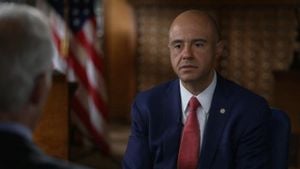Toronto is engulfed in heated discussions over the future of its bike lanes, especially with the city recently estimating the cost to remove them at over $48 million. This contentious move has drawn the attention of city officials, cyclists, and motorists alike, as all sides grapple with the financial, environmental, and logistical implications of the proposed changes.
Mayor Olivia Chow, known for her support of cycling infrastructure, pointed out the significant costs associated with the touted removals, prompting her to seek cooperative solutions between city hall and the provincial government. Speaking to media outlets such as CBC Radio, she underscored the importance of finding ground for collaboration on the matter, instead of pressing forward with the removal of bike lanes on major streets like Bloor, University, and Yonge.
The backdrop to these discussions is the Ontario government’s recent introduction of legislation requiring municipalities to get provincial approval for bike lanes, particularly any plans intending to swap out vehicle lanes. Chow, alongside her council members, expressed disappointment over this perceived overreach, as it appears to undermine local decision-making capabilities.
"We deserve respect as representatives of our constituents, whether they are pro or against bike lanes," Chow emphasized during the city council meetings. The stakes, she added, go beyond mere financial figures; they threaten to invoke significant changes to urban infrastructure which could take years to implement effectively.
On the surface, the $48 million estimate raises eyebrows, especially when previous removals cost significantly less—such as the $300,000 spent on bike lane removals on Jarvis Street. Critics of the city’s estimate, including government representatives, have challenged its validity and urged for more pragmatic approaches to traffic management.
According to the staff report released to the city council, the discussed costs encompass comprehensive road reconstruction and resurfacing plans. Chow is weighing legal options as well, anticipating the province's final regulations to assert the city's stance against what she calls "tremendous costs" to taxpayers.
This entire scenario aligns with transport minister Prabmeet Sarkaria's efforts to alleviate congestion across the city. Sarkaria has been vocal about improving traffic flow, mentioning the $11 billion lost annually due to gridlock. This rhetoric has taken shape with promises to prioritize the needs of car drivers over cyclists by minimizing the impact of bike lanes on vehicle traffic.
Chow contends, rather, the removal of these lanes might only raise traffic congestion issues, especially during construction, and lead to minimal improvements over existing travel times. The staff report supports her assertions, explaining how implementation of bike lanes often takes time to integrate with existing traffic patterns.
Some critics of the removals cite safety and environmental concerns, noting how the bike lanes have led to increased cycling on Toronto roads and reduced accidents, benefiting cyclists, pedestrians, and drivers.
Public sentiment is mixed. Cyclists are vehemently against the removals, highlighting the life-saving impact of bike lanes. Meanwhile, drivers express frustrations over congested streets, prompting some to call for greater balance between cycling infrastructure and vehicular traffic.
Chow's approach appears multifaceted. She’s expressed openness to redesigning specific lanes to mitigate motorist concerns without resorting to outright removal. Her commitment to finding solutions emphasizes the need for thoughtful engagement across all levels of government—a call for collaborative problem-solving as opposed to unilateral decision-making.
Chow also voiced the need for immediate steps to address traffic issues, citing infrastructure projects like the long-awaited Eglinton Light Rail Transit (LRT) line. This project has faced numerous delays and is seen as pivotal for easing congestion across the city.
Community feedback continues to shape these discussions, as public consultations and forums become increasingly frequent. Chow has indicated willingness to hear concerns from constituents to shape the future of biking and driving infrastructure.
This entire issue builds on existing tensions surrounding urban transportation and civic responsibility. It brings to light the broader challenge cities face globally—balancing the needs of diverse transportation modes against fast-evolving urban landscapes and climate responsibilities.
People are wondering if they will see any resolution soon. With legislative input from the province and significant financial hurdles presented by the city staff, these discussions are unlikely to settle any time soon as both government layers continue to draft their responses.
Nonetheless, amid the challenges, one thing remains clear: the need for dialogue between cyclists, motorists, and city officials remains imperative for shaping Toronto's future transportation dynamics. The sheer scope of this issue could encourage necessary reforms and lead to innovative solutions as the city moves forward.



